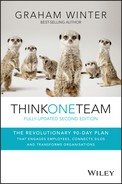part II
the think one team™ method
It is both natural and desirable for organisations to separate into smaller units such as divisions, departments and teams. This separation gives focus, specialisation and ownership, which offers the promise of greater efficiency and effectiveness, faster decision making and increased engagement for the people involved.
Unfortunately, this separation into units often comes at an unacceptable cost.
Instead of performance and growth, a ‘silo mentality’ emerges and people and customers see nothing but frustrating blockages that slow and suffocate the organisation.
When our consulting team receive calls from organisations seeking a solution to these concerns they hear comments such as:
- turf fights between functions are damaging the customer experience
- cost overruns on new initiatives are blowing out the budget
- getting a new product to market only happens when a leader rams it through from start to finish
- problems are sitting unclaimed in a stand-off between two divisions
- change is near impossible because the silos block everything.
the silos are not guilty
Not surprisingly, there has been a flood of books and articles encouraging leaders to ‘demolish the silos’ and replace them with a utopia of engaged people working together in one big community. This reeks of a technical solution to an adaptive problem and, unfortunately, it has encouraged many to try some type of ‘destroy the silos’ initiative, only to end up with worse performance due to outbreaks of status wars, conflicting priorities and resistance to change.
The core lesson is clear and repeatable: The silos are not guilty!
This is not about organisation structure. There are many examples of enterprises with silo structures that don’t suffer from the silo mentality and equally there are plenty that have tried open structures only to be crushed by tribalism and turf protection.
Let’s be clear: the ‘make or break’ is not about divisional or matrix structures — it’s about the practices and behaviours of alignment, collaboration and learning within and between teams. Put simply, the organisations that perform and adapt well in volatile and competitive environments are brilliant at teamwork across the same types of boundaries that others struggle to breach.
The think one team™ method reveals the five practices (called ‘the five shares’) that characterise these organisations.
In a world where every business needs to escape the limitations of silo behaviours the five shares are a simple and proven model and language for engaging and inspiring people to learn and adapt together.
The following section further explains the five shares and how to bring them to life in everything from day-to-day business to organisational transformation. Further details, including articles, examples of tools and program outlines, can be found at www.thinkoneteam.com.
